Related Research Articles

"Love Divine, All Loves Excelling" is a Christian hymn by Charles Wesley on Christian perfection. Judging by general repute, it is among Wesley's finest. Judging by its distribution, it is also among his most successful.
Erik Reginald Routley was an English Congregational churchman, theologian and musician and prominent hymnologist.

"Christ the Lord Is Risen Today" is a Christian hymn associated with Easter. Most of the stanzas were written by Charles Wesley, and the hymn appeared under the title "Hymn for Easter Day" in Hymns and Sacred Poems by Charles and John Wesley in 1739. The hymn eventually became well known for the "Alleluia" sung as a melisma after each line, which was added by an unknown author, probably to fit the commonly used hymn tune, "Easter Hymn". It remains a traditional processional hymn on Easter Sunday.

"Rock of Ages" is a popular Christian hymn written by the Reformed Anglican minister Augustus Toplady.

Once in Royal David's City is a Christmas carol originally written as a poem by Cecil Frances Alexander. The carol was first published in 1848 in her hymnbook Hymns for Little Children. A year later, the English organist Henry Gauntlett discovered the poem and set it to music.
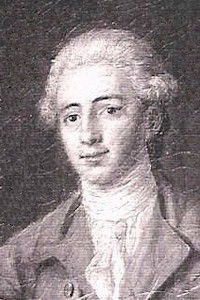
"All Hail the Power of Jesus' Name" is a Christian hymn.
"How Great Thou Art" is a Christian hymn based on an original Swedish hymn entitled "O Store Gud" written in 1885 by Carl Boberg (1859–1940). The English version of the hymn and its title are a loose translation by the English missionary Stuart K. Hine from 1949. The hymn was popularised by George Beverly Shea and Cliff Barrows during Billy Graham's crusades. It was voted the British public's favourite hymn by BBC's Songs of Praise. "How Great Thou Art" was ranked second on a list of the favourite hymns of all time in a survey by Christianity Today magazine in 2001 and in a nationwide poll by Songs Of Praise in 2019.
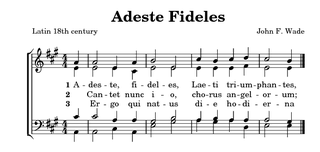
A hymn tune is the melody of a musical composition to which a hymn text is sung. Musically speaking, a hymn is generally understood to have four-part harmony, a fast harmonic rhythm, with or without refrain or chorus.
Hymnology is the scholarly study of religious song, or the hymn, in its many aspects, with particular focus on choral and congregational song. It may be more or less clearly distinguished from hymnody, the creation and practice of such song. Hymnologists, such as Erik Routley, may study the history and origins of hymns and of traditions of sung worship, the biographies of the women and men who have written hymns that have passed into choral or congregational use, the interrelationships between text and tune, the historical processes, both folk and redactional, that have changed hymn texts and hymn tunes over time, and the sociopolitical, theological and aesthetic arguments concerning various styles of sung worship.
"Come Thou Almighty King" is a Christian hymn of unknown authorship, which is attributed to Charles Wesley by Victorian and Edwardian hymnologists, but whose authorship is predominantly stated as "anonymous" in modern hymnals.
Bartholomäus Ringwaldt was a German didactic poet and Lutheran pastor. He is most recognized as a hymnwriter.
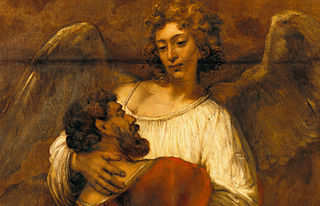
"Wrestling Jacob", also known by its incipit, "Come, O thou Traveller unknown", is a Christian hymn written by Methodist hymn writer Charles Wesley. It is based on the biblical account of Jacob wrestling with an angel, from Genesis 32:24-32, with Wesley interpreting this as an analogy for Christian conversion. First published in 1742, it has been included in every Methodist hymnbook since 1780. In its original form, it had fourteen stanzas, but it is rarely sung in its entirety. The hymn is commonly described as one of Charles Wesley's greatest compositions, with the hymn writer Isaac Watts quoted as saying that "that single poem, Wrestling Jacob, was worth all the verses he himself had written".

"Praise, my soul, the King of heaven" is a Christian hymn. Its text, which draws from Psalm 103, was written by Anglican divine Henry Francis Lyte. First published in 1834, it endures in modern hymnals to a setting written by John Goss in 1868, and remains one of the most popular hymns in English-speaking denominations.
"Good Christians All, Rejoice and Sing", originally titled "Good Christian Men, Rejoice", is an English Christian hymn written by Cyril Alington. It was first published in 1931 and is mostly used as an Easter hymn.

"Die güldne Sonne voll Freud und Wonne" is a Lutheran hymn by Paul Gerhardt. It is a morning hymn which was first published in 1666, with a four-part setting by Johann Georg Ebeling. Gerhardt created an unusual hymn metre for its 12 stanzas.
"Ermuntre dich, mein schwacher Geist" is a German Christmas carol with lyrics by Johann Rist and a melody by Johann Schop, first published in 1641. Historically it was contained in Protestant hymnals, but the current one, Evangelisches Gesangbuch, uses only three of its stanzas, the ninth, the second and the twelfth, titled "Brich an, du schönes Morgenlicht". This stanza was used by Johann Sebastian Bach as a chorale in Part II of his 1734 Christmas Oratorio.
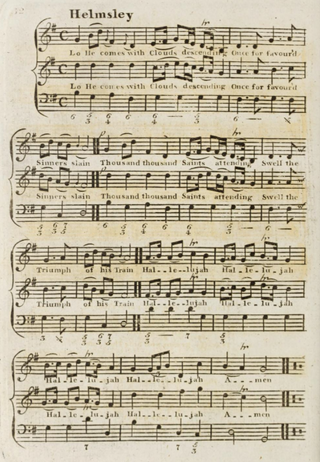
"Lo! He comes with clouds descending" is a Christian hymn by Charles Wesley (1707–1788), based on an earlier hymn, "Lo! He cometh, countless Trumpets" by John Cennick (1718–1755). Most commonly sung at Advent, the hymn derives its theological content from the Book of Revelation relating imagery of the Day of Judgment. Considered one of the "Great Four Anglican Hymns" in the 19th century, it is most commonly sung to the tune Helmsley, first published in 1763.
"Ye Choirs of New Jerusalem" or "Sing, Choirs of New Jerusalem" is an English Easter hymn by Robert Campbell. It is a 19th-century translation of the medieval Chorus novae Ierusalem, attributed to Fulbert of Chartres. The text's primary focus is the Resurrection of Jesus, taking the theme of Jesus as triumphant victor over death and deliverer of the prisoners from Hell.

"A Charge to Keep I Have" is a hymn written by Charles Wesley. It was first published in 1762 in Wesley's Short Hymns on Select Passages of the Holy Scriptures. The words are based on Leviticus 8:35. It is most commonly sung to the hymn tune Boylston by Lowell Mason.
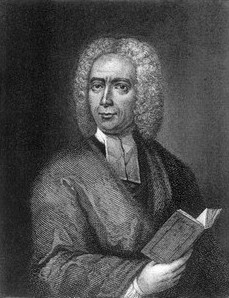
"Alas! and Did My Saviour Bleed" is a hymn by Isaac Watts, first published in 1707. The words describe the crucifixion of Jesus and reflect on an appropriate personal response to this event. The hymn is commonly sung with a refrain added in 1885 by Ralph E. Hudson; when this refrain is used, the hymn is sometimes known as "At the Cross". The final line of the first stanza has attracted some criticism, as it leads the singer to call themselves a "worm". Hymnals often change the line from "for such a worm as I" to "for such a one as I" or "for sinners such as I".
References
- Bradley, Ian C. (1990). The Penguin Book of Hymns. Penguin Group. ISBN 9780140092806.
- Wren, Brian (2000). Praying Twice: The Music and Words of Congregational Song. Westminster John Knox Press. ISBN 9780664256708.